As a new homeschooling mom, it can be overwhelming to know where to begin when picking the right homeschool curriculum. That’s why I’ve compiled a simple list for you, with the Best Homeschool Curriculum Picks for the School Year 2020-21.
From state laws, to co-ops and supplies, and of course, choosing a curriculum. There are a whole lotta options and a whole lotta people telling you what they use.
It seems that everybody has their favorite homeschool curriculum picks, and all the reviews are certainly helpful. However, I want to encourage you to thoroughly research with a discerning eye, realistic expectations, and self-awareness.
What am I really getting at?
It would be easy for a new homeschooling mom to just use the same curriculum as her bestie, or the veteran homeschooling powerhouse she follows on instagram. While their advice and choices are valued, please remember that they are not raising and educating your kids — you are!
Because more people are looking into homeschool than ever before, many friends have asked which curriculum I’m using since they know I will be a new homeschooling mom this year, too. I’m happy to share my homeschool curriculum picks with them, and with you, with the understanding that these are choices that (I hope) will work for my family, and it will take more than just reading this post to decide if it’s the right fit for yours, too.
**This post may contain affiliate links. That means if you click and buy, we may make a commission at no extra cost to you. Please see our full Disclosure Policy for more details.**
My Homeschool Curriculum Picks
I’ve found that I prefer an open-and-go curriculum. As a new homeschooling mom, I feel more comfortable with something that’s all put together, which will allow me to expound on specific areas when my creative juices are flowing. I also realized early on that I wouldn’t find ONE curriculum that would work for my family across the board, so I built our curriculum arsenal eclectically.
Here’s a break down of what my family will be using:
Math – Teaching Textbooks 3.0
I love that it’s online, will store my kids’ progress and scores on assignments and tests, and will accommodate my large family. They have an affordable family plan option for those with 4-8 children… only $200 for the whole year!
Students will take a placement test to determine where they should begin. I love this, because instead of assuming students will know or not know certain math concepts according to their age and grade, the placement test allows the curriculum to meet the children where they actually are.
Another bonus of Teaching Textbooks 3.0 is that it allows you to pause your membership when you know you’re not going to be using it. If you have a vacation planned, you can hit pause on your lessons and it won’t count towards your allotted year of access.
Also, because Math is one of the core subjects, I wanted my kids to look forward to doing it daily instead of viewing it as a chore. I knew my boys would be excited to use their new chrome books for this subject, so Teaching Textbooks 3.0 was a clear choice for us.
English – Institute for Excellence in Writing
Although I find their site difficult to navigate, their curriculum is really easy to understand and implement. IEW has a writing program, and a grammar program. These two programs are completely independent of each other, but compliment one another.
The writing curriculum is available in two options: Structure and Style and Theme-Based Writing. The difference between the two is Structure and Style is taught in video lessons by Andrew Pudewa, whereas the Theme-Based Writing is taught by you, the parent. I have chosen to do Structure and Style (the streaming option, not the DVDs) where my boys will watch a pre-recorded video (here’s an example of one) for each lesson and do the accompanying assignments the rest of the week.
I love that the student packets come with specific instructions for organizing their binders, what to do on which day, how to grade something as ambiguous as writing, and which things to let slide (for now).
Additionally, the students will have their own checklists to make sure they’ve included everything before handing it in to me, which will help make them accountable and give them a place to start.
>>Do you want to teach your child beneficial skills like organization, planning, and time management? Be sure to check out our Student Planners below!
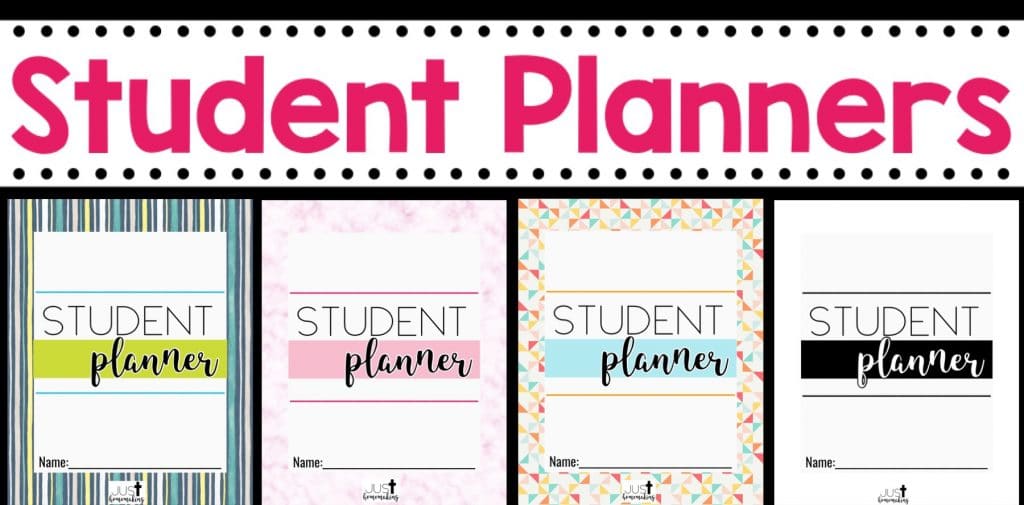
As a new homeschooling mom, I appreciate the clear, concise instructions that IEW provides for myself, as well as for my kids.
Their Fix-It Grammar program is such a unique way to teach grammar. Elements of grammar are introduced one sentence at a time. Students will correct a sentence a day and rewrite it the proper way. What’s really cool is the daily sentences are actually a novel that’s been separated sentence by sentence. So by the end of the book, the students will have read a novel in entirety, corrected errors, and re-written the whole story in its correct form!
It is suggested that every student starts on Book 1, The Nose Tree. (You’ll recognize later books like The Little Mermaid and Robin Hood.) There are placement tests for this too, but I’ve opted to start all of my boys (8th, 6th, 5th, and 3rd grades) on Book 1 because I’d like to combine when possible. We might do more than just the one sentence a day so we can move through the books a little quicker and cover more, depending on how the boys handle it. My guess is that my 8th grader will work more independently and zip through his a lot faster than my 3rd grader.
As I mentioned above, the Fix-It Grammar program is completely independent of IEW’s writing courses, but they do pair nicely together. For instance, in the Structure and Style lesson plan, if you’re on Week 1-Day 2 of the writing curriculum, the assignment will have you watching the writing video lesson, doing a keyword outline, and have a spot that says, “Optional: Complete Fix It Grammar sentence for Week 1-Day 2”. This allows the two programs to coincide without being reliant on each other.
History – The Good and The Beautiful
This curriculum is Christian-based, and completed family-style (where everyone sits and learns the same lesson together). It’s also super affordable!
There are four books of History, one for each school year. In the fifth year, you would do Year 1 again, but your students would be older and able to absorb more. I love that each year covers the same timeline, but stops at different points on that timeline. There are extensions for older kids to encourage deeper thinking.
They provide suggested reading lists that you can purchase from their site or obtain on your own. There are also fun things to keep it interesting, like a board game for review, a timeline with stickers, etc.
Science – Also The Good and The Beautiful
For Science, you’ll choose unit studies, there is no order to them.
Doing a lesson a couple times a week should have you completing 3-4 units a school year. So, I let each of my four boys pick a unit they were interested in, and we will work our way through them throughout the year.
I love that these are Open and Go, and you can see at the beginning of each lesson which supplies will be needed for experiments, etc.
Spelling / Handwriting – My plan with spelling is to curate my own lists/nab them from Pinterest.
One of my boys truly hates spelling and handwriting. To work with his preference for kinesthetic learning, our week of spelling will look like this:
Day 1: write each word twice
Day 2: spell each word with Scrabble tiles
Day 3: create a word search with your spelling words and swap with a brother
Day 4: use a game board (like Candy Land or Monopoly) and spell a word each time you roll the dice, advancing for each correct word
Day 5: test
I will combine spelling with handwriting to kill two birds with one stone. I also just purchased Cursive Logic because I like their approach of grouping letters that are formed the same way to help the student understand patterns in cursive.
Art – I’m currently perusing Kitchen Table Classroom’s The Artists and the Elements
All children are artists, but one of my boys is particularly Art Smart. I want to make sure to feed that part of him. I’m interested in this course because instead of just leading arts and crafts, it covers art history and teaches elements to creating art.
I haven’t officially decided on this one yet, but I’ll keep you posted.
Other Skills and Talents – Round Robin
I realized there were things I wanted my kids to work on regularly, but that didn’t require a ton of time each day if we did them consistently. I decided to have a “Round Robin” each afternoon, where the boys will spend 15 minutes on an activity before rotating to the next. I’ll probably commit an hour to 90 minutes each day for our Round Robin time.
These activities will include:
–Verse of the Week Printable for Teaching Kids Scripture
-Music or Instrument Practice
-Typing
-Student Planners
-Spelling/Handwriting
-Math Flash Cards
-Sports Conditioning
-Life Skills/Chores
Student Planners
In addition to choosing the right homeschool curriculum for my boys, I created these planners to help instill accountability, autonomy, organization, and time-management skills. I thought you might like them for your kid(s) too!
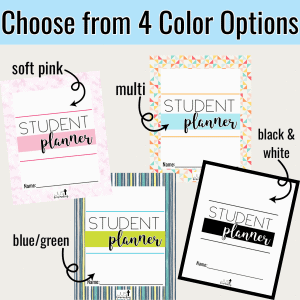
The Student Planners are offered in 4 different colors and come with over 40 stunning pages where everything can be kept in one place.
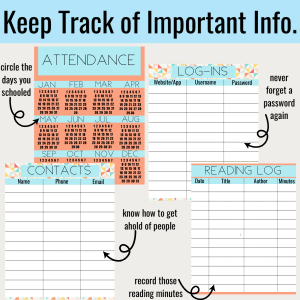
Your student will learn how to think through a project or paper.
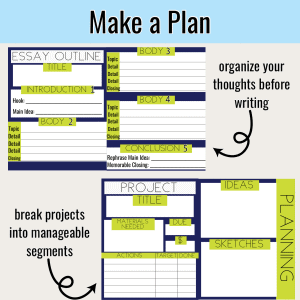
He or she can be responsible for keeping track of assignments, due dates, tests, and other important things throughout their week.
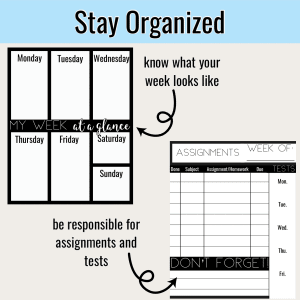
A yearly calendar (through 2023) is provided to help your child(ren) remember important dates.
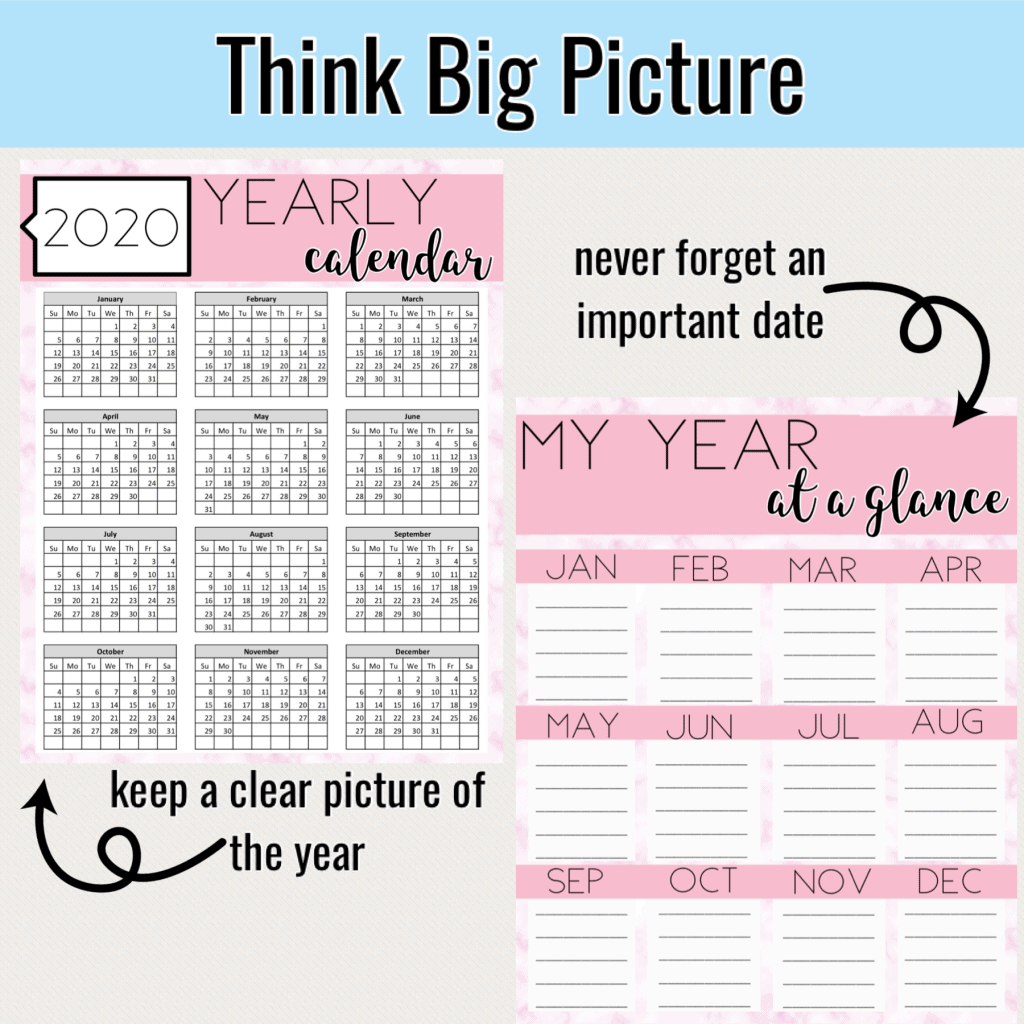
The Student Planner also includes a couple of helpful extras.

The best part? The Student Planners are not dated, so you can buy it ONCE and be able to reprint it each year FOR LIFE. (There are yearly calendars included through 2023, and updated sheets will be available when the time comes). As a frugal consumer myself, I love purchasing something that has re-usability.
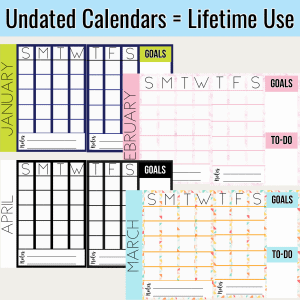
>>The planners are printable as a digital download via Google Drive. You can print at home, or at your favorite print shop. Print all pages or just the ones that are applicable to your family’s needs. The pages were designed at a size of 8×10. Personally, I will print them on 8.5×11 cardstock to allow room for 3-hole punching, as my children will be using these planners in binders. You may choose to have yours spiral-bound, or some other system that works for you and your child(ren).
>>>HOW TO GET YOUR HANDS ON THESE AWESOME STUDENT PLANNERS
- To pay full price, use this link.
- To receive an exclusive discount plus access to two free printables, see “Your Special Offer” below.
Your Special Offer
As a thank you, we are offering our newsletter subscribers an exclusive discount of 25% off our Student Planners, plus these Free Printables to help with maintaining some order to your homeschool environment.
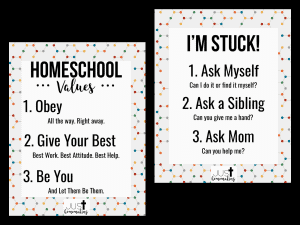
As a new subscriber, you can expect one e-newsletter in your inbox weekly, and can unsubscribe at any time. But you probably won’t want to because our newsletters are full of goodies like:
- First Access to Blog Posts
- Tips & Tricks
- Motivating Challenges
- Free Printables (like these!)
- First looks and discounts on new products
- & More!
>>>Ready for your discount and free printables?! Tap here.
Next Steps
Happy Researching, from one new homeschooling mom to another! I hope this was a helpful read in your research. I know you will find the perfect fit for your family, and soon people will be asking you for your homeschool curriculum picks!
Please let me know if you have any questions and I will do my best to answer them, or guide you to a source that can.


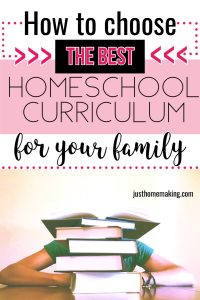
This is extremely helpful! Thank you for laying everything out in a way that it isn’t overwhelming! You broke it down so well. The planners are beautiful as well!
Thanks, Melissa! I’m so glad you found it helpful!
This was so helpful Jenna! Love your organization and tips!
Oh, I’m so glad Heather! Holler if you have any questions!